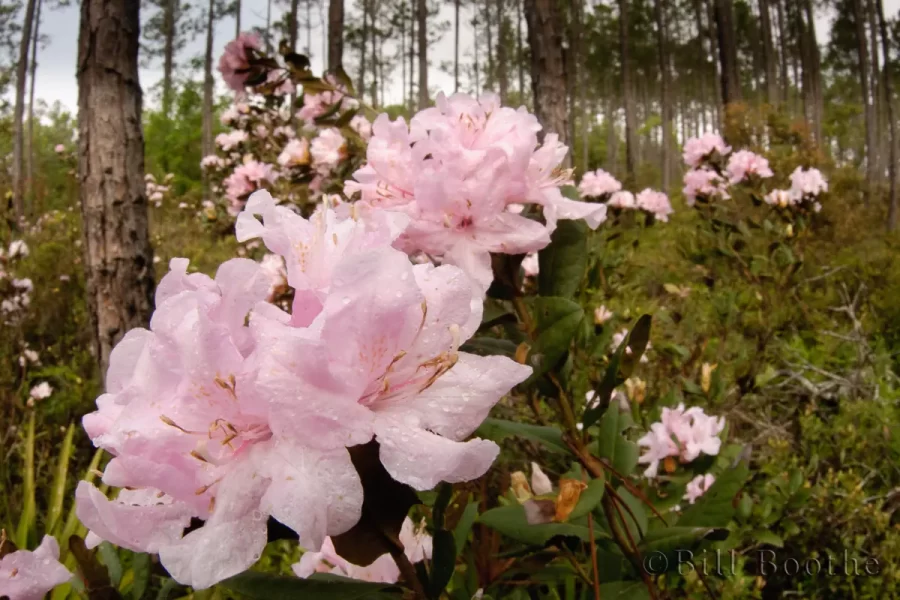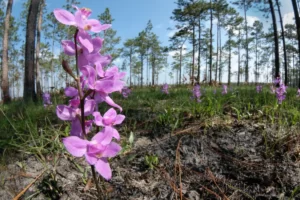Springtime is always a wonderful time to visit your local botanical garden, park, or arboretum. While there may be an unending succession of blooming flowers in the spring, it is almost a ritual in some areas to visit the gardens when the azaleas are blooming. Possibly the most renowned azalea gardens are found on the plantations surrounding Charleston, South Carolina. After enjoying the azalea spectacle at Middleton Plantation, Magnolia Plantation, and Cypress Gardens, many of the crowds proceed to Summerville, a town just outside of Charleston, where my parents lived. For one or two weeks each year, this small town swells in size as thousands of people come from all over the United States to see the azaleas that grace the old houses and gardens of “Flower Town.”
Today azaleas figure prominently in the landscapes of gardens throughout the United States. A walkway in the Arboretum at the University of Washington in Seattle meanders through a breathtaking collection of red, pink, and white azaleas. Our National Arboretum in Washington, D.C., has a glorious hillside covered by azaleas. While the relentless heat of central and south Florida’s long hot summers precludes the inclusion of azaleas in most people’s yards, they are still a crowd-pleaser in many of Florida’s public gardens. Bok Tower, Cypress Gardens, and Maclay Gardens are just some of Florida’s gardens which have imposing plantings of azaleas.
It may be hard to visualize a landscape without the familiar azaleas, but, in fact, none of these azaleas are native to North America. They are cultivated hybrids of Old World species collected in the Himalayas, China, and Java. In the early eighteenth century, North American azaleas such as the Pink Azalea (Rhododendron clymenoides) and Mountain Flame Azalea (R. calendulasceum) were exported to Europe where Belgians and Britons crossed them with Oriental species. Due to the popularity of the azalea in Flanders, it became a Flemish symbol. By the 1820’s, azalea hybrids were sought by gardeners worldwide and were imported into the United States.
One does not have to head for civilized gardens to appreciate azaleas. Wildflower enthusiasts will trek to the woods and ravines of the Florida panhandle to admire the wild species. At Torreya State Park, patches of white, pink, orange, yellow, and red azalea flowers burst through the hardwood trees that are just beginning to leaf out. Azaleas also clamber through vegetation along the roadsides near Ochlockonee River State Park. Unlike their garden cousins which have sacrificed most of their flower scent for more numerous and showier flowers, the native azaleas perfume the air with spicy fragrance. This fragrance, along with the tubular shape of the flowers, have earned wild azaleas the name of Wild Honeysuckle. The fragrance’s intensity varies with time of day. Some individuals find the perfume of the flowers overpowering and give the flowers a less complimentary name: headache flowers.
The fragrance of the azaleas advertises a rich source of nectar to insect visitors such as honeybees, bumblebees, ants, and butterflies. Bees use the protruding style as a landing strip and crawl into the throat of the flower to reach the nectaries. As they do so, they are dusted by the pollen on the anthers. When they land on the style of the next azalea, the pollen on their belly is transferred to the style’s stigma. The fertilized flowers form small capsules that split lengthwise into five sections to release numerous tiny flat seeds. These seeds are dispersed by river currents, winds, and possibly by hitching a ride in animals’ fur and birds’ feathers.
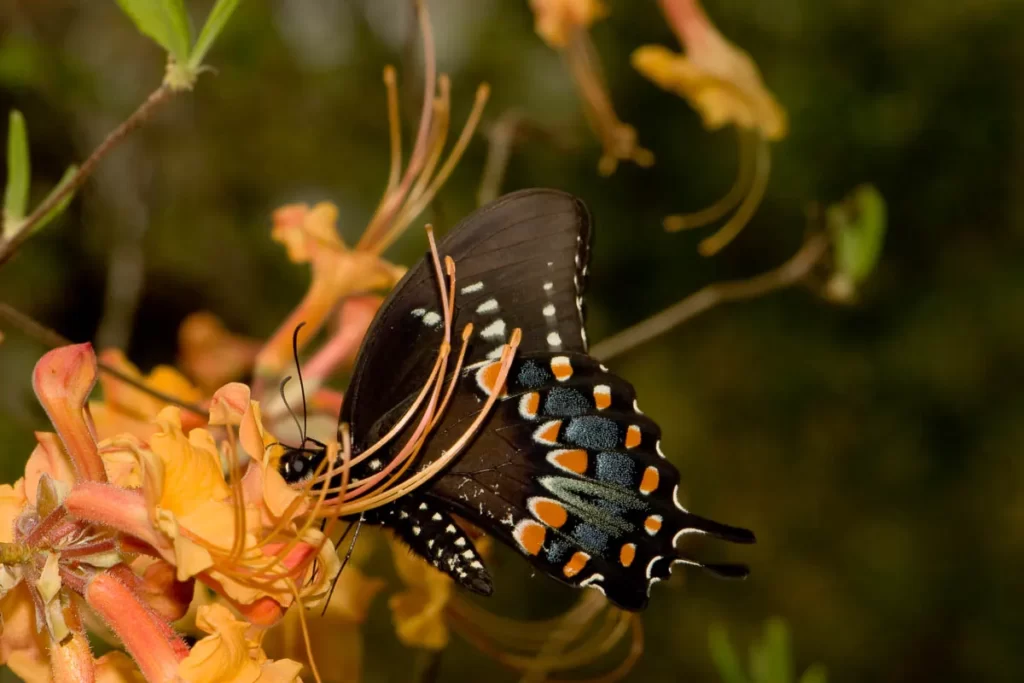
Tiger swallowtails, palamedes swallowtails, spicebush swallowtails, gulf fritillaries, and migrating monarchs also enjoy the copious nectar. Smaller butterflies such as hairstreaks and skippers do not have long enough proboscides to reach into the flower’s throat so they crawl inside the blossom to reach the nectaries.
Azaleas may be deciduous or evergreen. Although evergreen azaleas with leathery leaves are traditionally called rhododendrons by gardeners and nurserymen, both azaleas and rhododendrons now belong to the Rhododendron genus. At the time that Carl Linnaeus was assigning Latin names to plant species, he thought incorrectly that all azalea species grew in dry locations. For this reason, he named these shrubs and trees Azalea, an adaptation of azaleaos, the Greek word for dry.
More than 600 species of wild azaleas and rhododendrons are found in the cool temperate regions of the Northern Hemisphere. Only one species is found south of the equator. The majority of the world’s azaleas are found in the Himalayas while only 24 species grow in North America.
All of North America’s deciduous azaleas are shrubs, but three evergreen species do reach tree size. These trees are covered by large showy flower clusters, each made of ten to thirty individual blossoms. These roselike flower clusters which can reach five inches across do justice to the trees’ name, rhododendron, which means rose tree (rhodon = rose, dendron = tree).
The Rosebay Rhododendron or Great-laurel (R. maximum) is a prominent feature of the Allegheny and Appalachian mountainsides. Its evergreen leathery leaves remind one of a bay tree and its clusters of rose-pink flowers spotted with yellow and orange do look like roses. These blossoms are the state flower of West Virginia. This rhododendron can be over 30 feet tall and can have a 13-inch diameter trunk. Higher up on the same mountainsides, mostly above 3,000 feet, is the Mountain Rosebay or Catawba Rhododendron (R. catawbiense). This small tree is over 20 feet tall and has a trunk with a 5-inch diameter. This rhododendron with lilac-colored flowers is the parent of many modern azalea hybrids. The Pacific Rhododendron (R. macrophyllum), found in the mountains of California, the Pacific Northwest, and British Columbia, is a 25-foot tall tree with clusters of white to pink flowers.
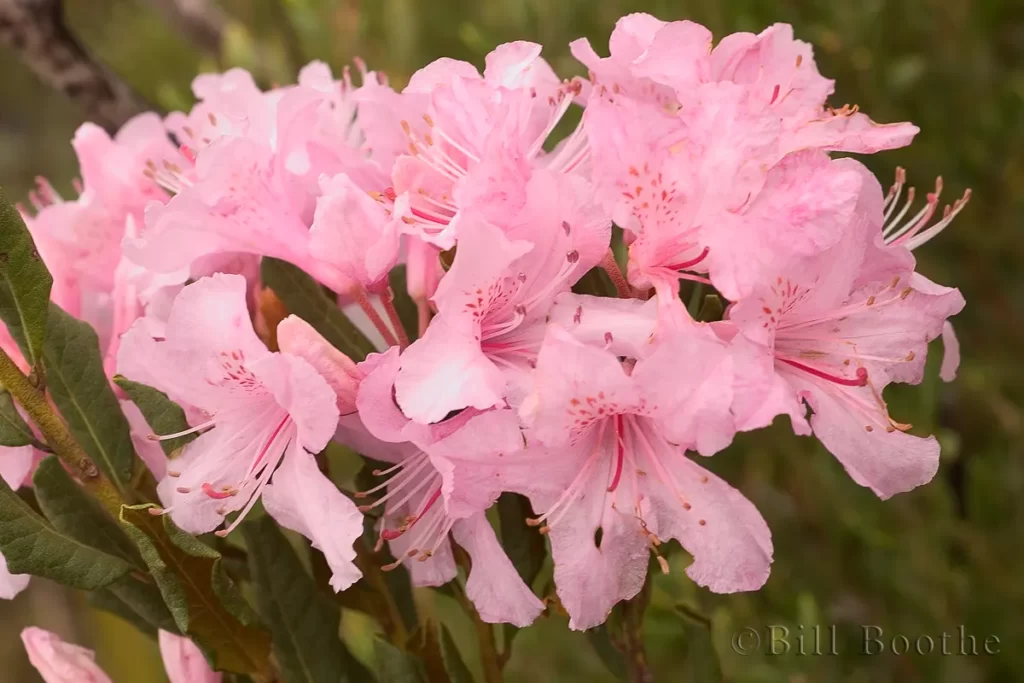
Florida’s single evergreen azalea is the Chapman’s Rhododendron (Rhododendron minus v. chapmanii). This endangered shrub is found only in Gulf, Gadsden, Leon, Franklin, and Liberty counties in the Florida Panhandle. It prefers wet situations and grows along the edges of titi swamps and in pine flatwoods. The shrub does not exceed ten feet in height. Its 1.5 to 3.5 cm long flowers bloom from March to April. The pink to rose-pink flowers have magenta tubes and spotted lobes. The stamens with white filaments barely extend beyond the lip of the flower. Besides its evergreen leaves, the Chapman’s Rhododendron can be separated from other pink-flowering azaleas by noting that there are ten instead of the usual five stamens in each flower. When not blooming, look for small yellow or rust-colored dots on the undersides of the leaves. No other Florida azalea has these dots.
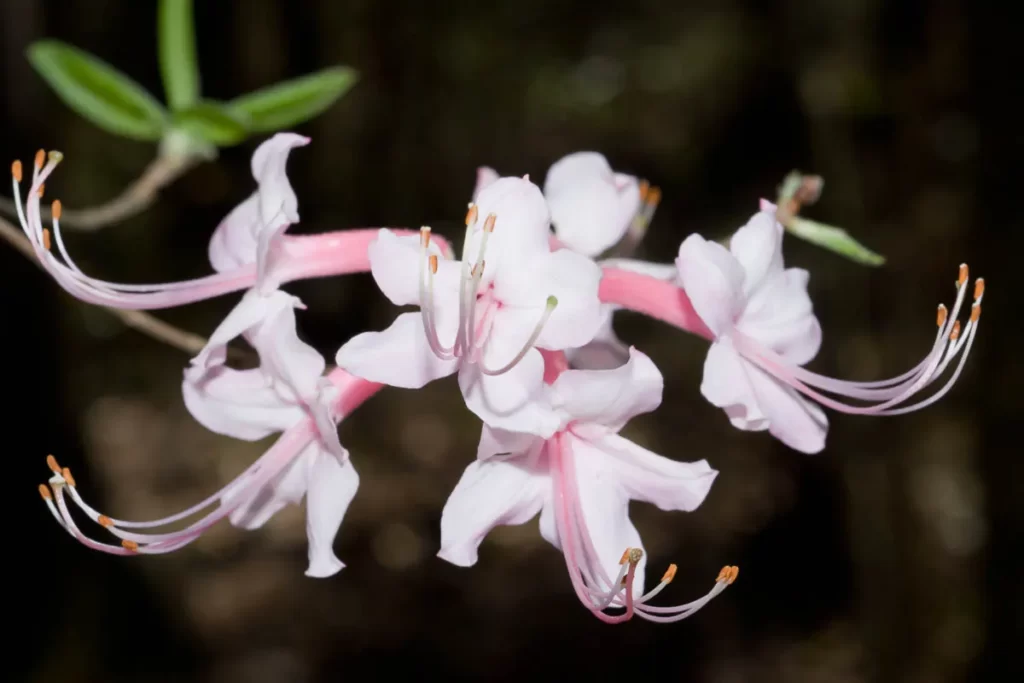
The most common and widespread azalea of the southeastern United States is the Sweet Pinxter Azalea (R. canescens), sometimes simply called the Wild Azalea. Found throughout the Florida Panhandle, northeastern Florida, and south to the Gainesville area, this azalea grows in the acid sandy soils of flatwoods, bay swamps, bluffs, hammocks, and limestone sinks.
This tall shrub, around fifteen feet tall, has thin elliptic leaves and pale pink to almost white flowers. The flowers, one inch across and one to two inches long, are smaller than many of the other azaleas. The five stamens with pink filaments are three times longer than the flower. The pink style is even longer. The slightly fragrant blossoms can be distinguished from other azaleas by the soft hairs that cover the flowers. This soft fuzz gave rise to the species name canescens which means softly hairy and to another of the shrub’s many common names, the Hoary Azalea. It blooms between February and April before the shrub leafs out.
First collected in South Carolina by André Michaux in the late 1700’s, this and several other azaleas were christened pinxterblooms by Peter Kalm, a Swedish botanist who lived in New York. Pinxter has nothing whatever to do with the pink color of the flowers, but is based on Kalm’s observation that one species of azalea (R. periclymenoides) was blooming on Whitsuntide, the seventh Sunday after Easter. This religious holiday is the Feast of Pentecost, which New York’s Dutch population called pinxter, hence the name pinxterbloom.

The Swamp Honeysuckle (R. viscosum) is a deciduous shrub that prefers moist pine flatwoods and swamps. This shrub has the southernmost range of Florida’s azaleas. It is found in most of the Florida Panhandle and northern Florida and extends as far south as Manatee, De Soto and Highlands counties. This late-blooming azalea does not flower until its leaves are fully mature, any time from June to September. The shrub can be quite tall, reaching almost twenty feet in height. Its white to cream blossoms may have pink stripes or be tinged pink. The very fragrant blossoms have a spicy clove-like aroma. The flowers are very sticky and can ensnare ants and other insects that are attracted to the flowers’ nectar. Six to ten blossoms are in each flower cluster. The five stamens with yellow filaments are one to two times longer than the flower. The purple style is much longer than the stamens. The flowers are up to an inch long.
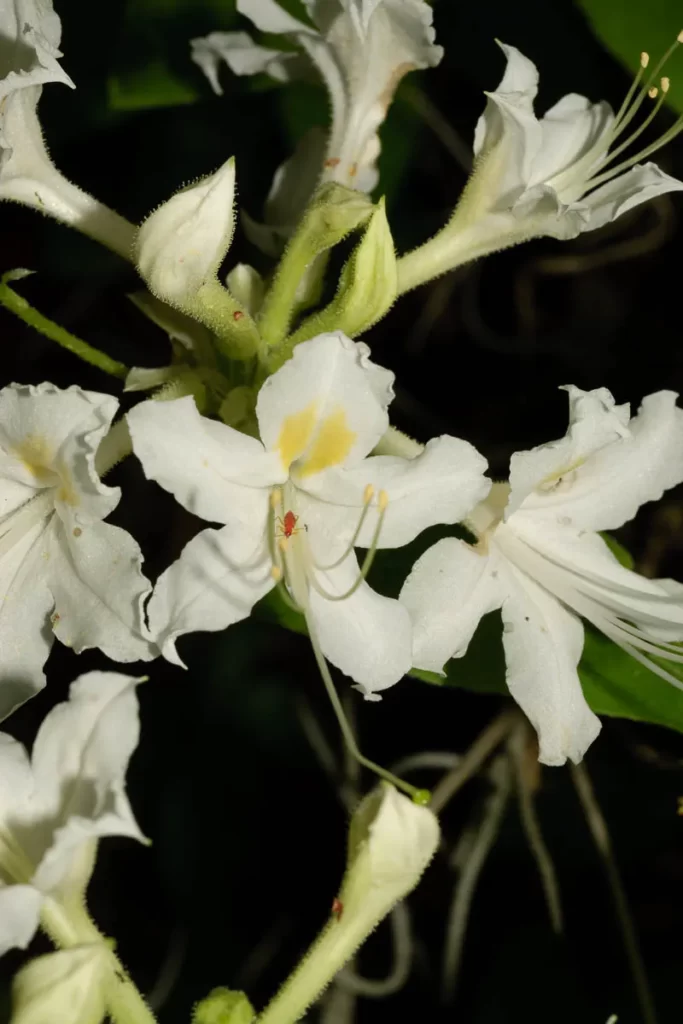
The Alabama Azalea (R. alabamense) is named after the state where it was discovered in 1883. It is also found in western Georgia and central Tennessee. In Florida, this azalea is found in the hammocks and well-drained woodlands in Gadsden, Leon, Jackson, and Jefferson counties that surround Tallahassee. This deciduous shrub has many suckers and is less than fifteen feet tall. In April, one can smell the intense sweet lemony fragrance of its white blossoms. Its crushed leaves also have a distinct odor. Five to fifteen blooms may be found in each flower cluster. The inch or more long white flowers are one and a half inches wide. Unlike other azaleas which may also have white flowers, the upper lobes of these flowers always have a yellow splotch. The white filaments of the five stamens are twice as long as the flower.
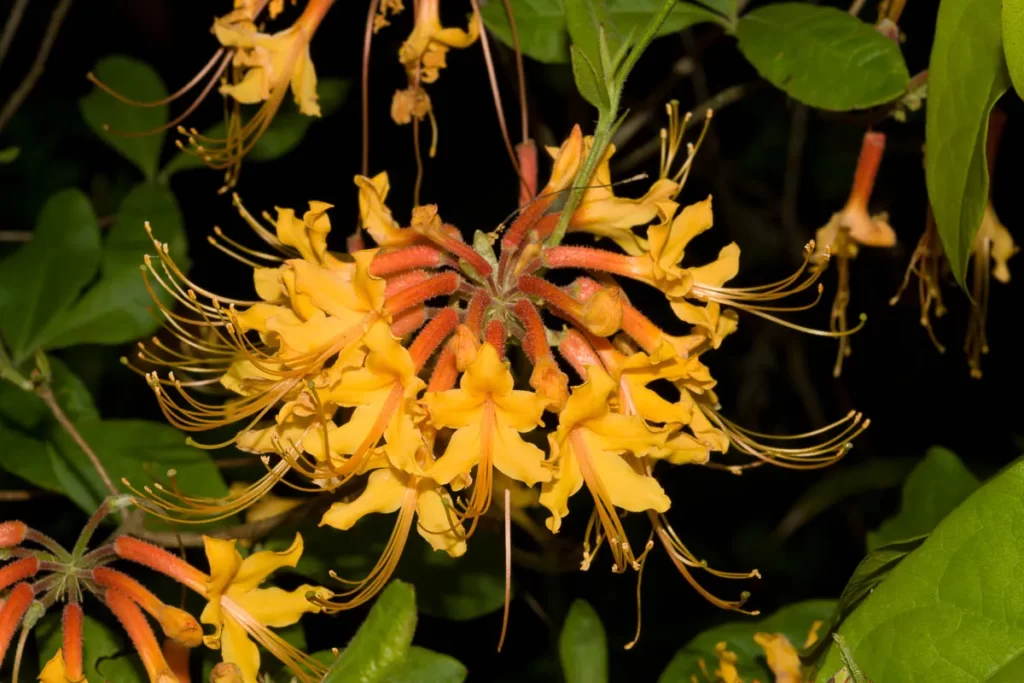
Unlike Florida’s other azaleas which have pink or white flowers, the Florida Flame Azalea (R. austrinum), also variously known as the Florida Azalea and Orange Azalea, has yellow, orange, or reddish-orange blooms. Clusters of eight to fifteen trumpet flowers are on the tips of the branches. The one to two-inch long flowers bloom in March and April before or during the emergence of the shrub’s new leaves. The deciduous shrub, up to twenty feet tall, is found on the bluffs, hammocks, and floodplains of the Florida Panhandle as well as parts of Georgia and Alabama. The faintly fragrant flowers have five long stamens, two to three times longer than the flower itself. When not in bloom, look for the tiny reddish hairs that cover the leaves and branches of the Florida Flame Azalea.
Flower coloration is not a reliable way to identify the different wild azaleas since hybridization among the species is quite prevalent. In fact, the Alabama Azalea so freely hybridizes with the Sweet Pinxter Azalea that it can be difficult to find a purebred specimens of the former. These hybrids are taller than the usual Alabama Azalea and have pale pink flowers with one to three yellow-splotched lobes. It is also quite common for the Florida Flame azalea to hybridize with the Sweet Pinxter Azalea. Flowers of these hybrids are also pink, but have reddish corolla tubes.
It seems only fitting that South Carolina, the home of some of the country’s most spectacular azalea gardens, should also be the locale of one of North America’s most splendid native azaleas, the Mountain Flame Azalea (R. calendulaceum). In May 1774, William Bartram was traveling along the bluffs near the Broad and Savannah Rivers of north Georgia. The account of this botanist says it all:
In these cool, sequestered, rocky vales, we behold the following celebrated beauties of the hills, fragrant Calycanthus, blushing Rhododendron ferrugineum, delicate Philadelphus inodorus, which displays the white wavy mantle, with the sky robed Delphinium, perfumed Convallaria and fiery Azalea, flaming on the ascending hills or wavy surface of the gliding brooks. The epithet fiery, I annex to this most celebrated species of azalea, as being expressive of the appearance of its flowers, which are in general of the colour of the finest red lead, orange and bright gold, as well as yellow and cream colour; these various splendid colours are not only in separate plants, but frequently all the varieties and shades are seen in separate branches on the same plant; and the clusters of the blossoms cover the shrubs in such incredible profusion of the hill sides, that suddenly opening to view from dark shades, we are alarmed with the apprehension of the hill being set on fire. This is certainly the most gay and brilliant flowering shrub yet known: it grows in little copses or clumps, in open forests as well as dark groves, with other shrubs, and about the bases of hills, especially where brooks and rivulets wind about them: the bushes seldom rise above six or seven feet in height, and generally but three, four, and five, but branch and spread their tops greatly; the young leaves are but very small whilst the shrubs are in bloom, from which circumstance the plant exhibits a greater show of splendour.
William Bartram, May 1774
It is this loveliness that has led to the depletion of many native azaleas throughout the United States. Adding to this misfortune is the sad fact that azaleas transplanted from the wild rarely survive. A youthful-looking ten-foot tall shrub may in fact be almost a century old. Nursery-grown stock is now available for most native varieties.
All of Florida’s azaleas are now protected by state and federal law. Even the Sweet Pinxter, one of the southeast’s most common azaleas, is listed as “commercially exploited.”
If one still needs to ask what benefits are provided by azaleas, consider what Ralph Waldo Emerson said of the Rhodora, a rhododendron found in the northeast:
Ralph Waldo Emerson (1803-1882)
